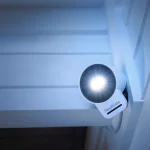HTC has joined the mid-range “phablet” fray with the Desire 816, a big phone-tablet crossover that costs only $300 with no contract.
It’s the company’s first attempt at a low-cost, large-screen phone in the United States. ile it lacks the frills of a flagship device, its camera is a disappointment, the phone is still worth considering at $300 off-contract with Virgin Mobile, whose plans start at $35 per month.
Fine phablet form
Don’t expect the svelte frame of an ione 6 us or the aluminum trim of a Galaxy Note 4 here. The Desire 816 is all plastic, with gray matte material on the front sides, a glossy fingerprint magnet rear shell. The black bezel around the screen is somewhat thick, but doesn’t seem out of proportion to the 5.5-inch display.
The screen is just 720p resolution, which at this size produces slightly jagged edges on text icons. Display quality isn’t an issue, however, as the Desire 816’s Super D panel provides consistent colors regardless of the viewing angle.
The Desire 816 also has a pair of “BoomSound” speakers on the front panel. HTC didn’t skimp here, as the speakers are as loud rich as those of the top-shelf HTC One (M8). Combined with the larger screen, the front-facing speakers turn the Desire 816 into an impressive portable video player gaming device.


The Desire 816’s BoomSound speakers are as lucious as ones on HTC’s flagship phones.
must point out one significant flaw in our review unit: It shipped with a sticky power button that wouldn’t immediately pop out when pressed. Over time, the button became stickier, eventually wouldn’t pop out at all, causing the phone’s restart prompt to pop up. It’s doubtful that this problem affects all units, but it’s something to watch out for.
rformance software
th a quad-core Snapdragon 400 processor 1.5 GB of RAM, the HTC Desire 816 is running on the kind of specs you’d find in a late-2012 flagship, is on par with many of this years lower-cost phones. Still, the phone hled transitions animations smoothly, barely skipped a beat when switching between apps, performed well at 3D games such as Asphalt 8 Expendables: Rearmed. The most noticeable performance hitches came during b browsing, as heavier pages sometimes struggled with lag choppiness.
Unfortunately, the Desire 816’s media capabilities are hamstrung by a mere 8 GB of advertised storage, which translates to about 4 GB of usable space. If you plan to store more than a hful of movies games, you’ll need to pop in a MicroSD card.


The Desire 816 has a MicroSD slot to make up for its meager internal storage.
ile a big battery is usually one of the main advantages of a phablet, the Desire 816’s 2600 mAh battery is small for a phone of this size. It lasted for 8 hours 31 minutes in our stard video test, compared to 11 hours for the Samsung Galaxy Note 3’s 3200 mAh battery.
For software, the Desire 816 uses HTC’s Sense 6 interface, running atop Android 4.4 KitKat. HTC’s take on Android is a mostly pleasant affair, with useful add-ons such as a customizable quick settings menu, scheduled Do Not Disturb mode, extreme power saver mode the BlinkFeed news ticker on the home screen.
However, the phone includes one rather annoying bit of bloatware called Qualcomm iZat. Its intended purpose is to provide indoor location tracking at places like shopping malls, but the app doesn’t make any of this clear as it periodically bugs you with notifications. It comes off as creepy apparently doesn’t even work anywhere in the United States, making it a textbook example of how no to do pre-loaded software.
Tragically flawed camera
The Desire 816 packs an impressive-sounding 13-megapixel camera, but the photos aren’t as good as the pixel count implies. ile the camera had a fast shutter was able to capture fine details, photos came out with a yellow hue, as if taken on an old laroid. The effect was especially pronounced indoors.


The Desire 816’s camera makes a messy home office even more unsightly.


The Desire 816 gives outdoor photos a slightly yellow tint.
The front-facing camera—despite a generous 5-megapixel sensor—had similar color issues, its field of view is only wide enough to fit a couple of people in the frame at arm’s length. For mid-range phone that’s otherwise so solid, the camera is one area where the Desire 816 is decidedly cheap.
If you can live with the camera a few other shortcomings, the Desire 816 fares well as a budget phone for game media junkies. For $300, it can st in for both a smartphone a tablet, the service comes cheap on Virgin Mobile, whose $35 plan gets you 300 minutes, unlimited text 2.5 GB of high-speed data. (An alternative plan for the same price includes unlimited minutes 250 MB of data.) It could be the only device you need, even though it’s far from being the best one you can get.


















